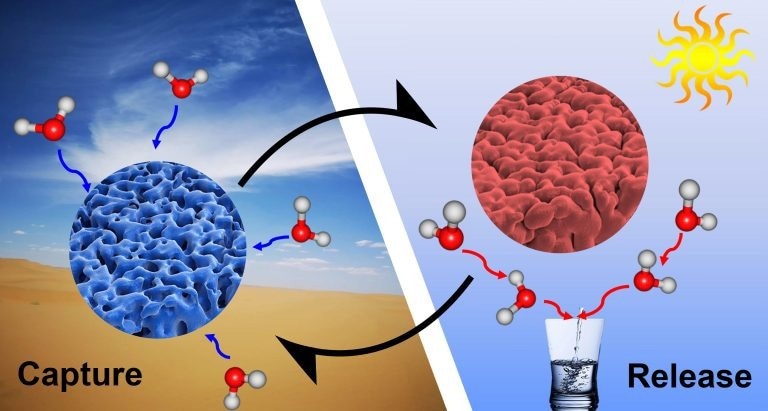More than 2.2 billion people today live in water-stressed nations, and the United Nations estimates that 3.5 million people die each year from diseases associated with water. Because the locations most in need of better drinking water are also located in some of the sunniest parts of the planet, there is an immense interest in harnessing sunlight to assist in acquiring clean water.

Schematic diagram of the daytime atmospheric water harvesting cycle. Image Credit: Wang Ruzhu
Shanghai Jiao Tong University researchers in China created a potential new solar-powered atmospheric water collecting system that might help provide adequate drinking water for people to survive in those harsh, dryland areas. They reported their findings in the AIP Publishing journal Applied Physics Reviews.
This atmospheric water harvesting technology can be used to increase the daily water supply needs, such as household drinking water, industrial water, and water for personal hygiene.
Ruzhu Wang, Study Author and Professor, Institute of Refrigeration and Cryogenics, Shanghai Jiao Tong University
Historically, researchers encountered difficulties while injecting salt into hydrogels since the higher the salt concentration, the lower the hydrogel’s expanding ability due to the salting-out phenomenon. This resulted in salt leaks and a reduction in water absorption capacity.
Wang added, “We were impressed that even when up to 5 grams of salt was injected into 1 gram of polymer, the resulting gel maintained good swelling and salt-trapping properties.”
Using plant derivatives and hygroscopic salts, the researchers created a super hygroscopic gel capable of absorbing and holding an unprecedented quantity of water. In arid atmospheric circumstances, one kilogram of dry gel might absorb 1.18 kg of water and up to 6.4 kg in humid atmospheric situations. This hygroscopic gel was simple and affordable to make, making it suited for large-scale production.
In addition, the researchers used a prototype with simultaneous desorption and condensation chambers. They used a turbofan in the condensation chamber to collect more than 90% of the desorbed water.
During an outdoor prototype demonstration, the researchers discovered that it released adsorbed water even when the sun was weak in the morning or afternoon. During the day, the system could also perform simultaneous adsorption and desorption.
To further enhance the system’s performance for practical applications in water generation, the team will attempt to accomplish simultaneous adsorption and desorption utilizing renewable energy to maximize daily water yield per unit mass of adsorbent.
Aside from daily water production, sorbent materials that gather atmospheric water might be useful in future applications such as dehumidification, agricultural irrigation, and thermal management for electronic equipment.
Journal Reference
Xiang, C, et. al. (2023) Daytime air–water harvesting based on super hygroscopic porous gels with simultaneous adsorption–desorption. Applied Physics Reviews. doi:10.1063/5.0160682.